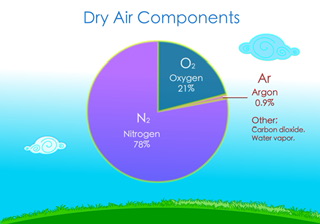We'll be back in a bit !
The system is currently undergoing a routine upgrade to ensure you get the best learning experience. The maintenance is expected to continue till 8:00 pm. Please check back later.
Thank you for your understanding!

Air is not a single substance, but rather a combination of various gases, as was discovered by English physician John Mayow in 1674. The scientific finding has broad implications for understanding the nature of the atmosphere. In 1774, chemist Joseph Priestley found oxygen in the air. Joseph Black, a chemist of 1750 discovered the presence of Carbon dioxide in the air. In 1772, Daniel Rutherford found what was then known as poisonous air; today, we know it as nitrogen gas. The 0.7% of the air that is absent due to some unknown component bothered Henry Cavendish back in 1785. He conducted several experiments leading up to the discovery, but it took scientists 100 years to confirm that it is, in fact, a less reactive Argon compound. Argon gas was first spotted in the atmosphere by William Ramsay in 1894.
Multiple gases work together to form air. Nitrogen, Oxygen, and Argon are the primary elements of air. The atmosphere also contains several other gases besides those listed above. But they are in less composition compared to these gases. The main component of air is the gas Nitrogen. Nitrogen gas accounts for around 78 percent of Earth's atmosphere. Around 21% comes from other gases like oxygen, while 0.9% comes from argon. These main gases are joined by a few trace gases. Some examples of these gases are Xenon, Krypton, and Helium, while others include Hydrogen, Ozone, and Methane. The types of gases in the air fluctuate with altitude and weather conditions.
Water vapor is also present in the air, with concentrations ranging from 0.25% on average to much higher or lower depending on the surrounding conditions. Water droplets are also present in the humid air. However, these are all elements that originated in nature. Yet there are some man-made contaminants too. And these contribute to air pollution by being toxic.
Components of air
Many different gases fill the Earth's atmosphere. But these gases are colorless and odorless, we cannot see them with our naked eyes. The air everywhere has the same percentage of components, however, the quantity of molecules of gases varies depending on location. The water content varies in different locations and is due to the changing temperature. When you ascend 100 meters into the atmosphere, the temperature drops by around 0.6 degrees Celsius. The air everywhere is nearly identical in composition. The average values of air's various components are listed below.
Some gases are also present in trace amounts in the air:
The air's constituents are crucial to all forms of life on Earth. Animals and plants can breathe because the air contains gases. Also blocks the sun's harmful ultraviolet rays. So, their usefulness is quite broad. These gases are only effective when present in the correct concentrations. Inadequate quantities may also be problematic. Their location is also an important factor. Ozone is a harmful gas that might potentially reach Earth's surface.
The primary substances found there confer significance. The majority of the elements present in the air are nitrogen (78%) and oxygen (22%). For both plant and animal development and reproduction, this naturally occurring element is crucial. Oxygen, with 20.9%, is the second most significant. We can all agree that oxygen is necessary for life to exist. Life can't continue without oxygen. While these components account for nearly all of the air we breathe, there are a few additional species present in trace amounts. wherein Argon makes up the vast majority (99%). Yet, since air is so expensive, this does not imply that nitrogen and oxygen are the only components. Nitrogen, oxygen, and argon make up the bulk of the elements. And a few more, such as carbon monoxide, nitrous oxide, helium, hydrogen, etc.
Air is what surrounds us. It is a mixture of different cases. Even though the composition of gases present in the atmosphere does not make any sense. But it is an important value since air is a vast thing. Scientists have made different experiments to get a clear idea about the gases present in the atmosphere. It has been expanded with the evolution of more instruments discovered by scientists. The role of these gases is also very important. Since these gases are responsible for the existence of life on Earth. The major contribution of gases present in the air is Nitrogen. Then comes the Oxygen and then Argon. In addition to these major components, some amounts of other gases are also present such as Hydrogen, Helium, Carbon dioxide, etc.
1. What is the air quality index?
Government agencies provide the public with information on air quality via an Air Quality Index (AQI) number. If the AQI keeps climbing, a lot of people are going to start feeling bad about their health.
2. Is water vapor a greenhouse gas?
The heat-trapping properties of water vapor make it another greenhouse gas with an important role to play in climate feedback. Because of this property, we see that moistness may be held in warmer air better than in cooler air.
3. What are the major causes of global warming?
The rise in temperature due to the extensive release of greenhouse gases in the atmosphere is global warming. The burning of fuel releases a large amount of Carbon dioxide into the atmosphere. And this will make our planet raise the temperature. This phenomenon occurs due to human intervention.
